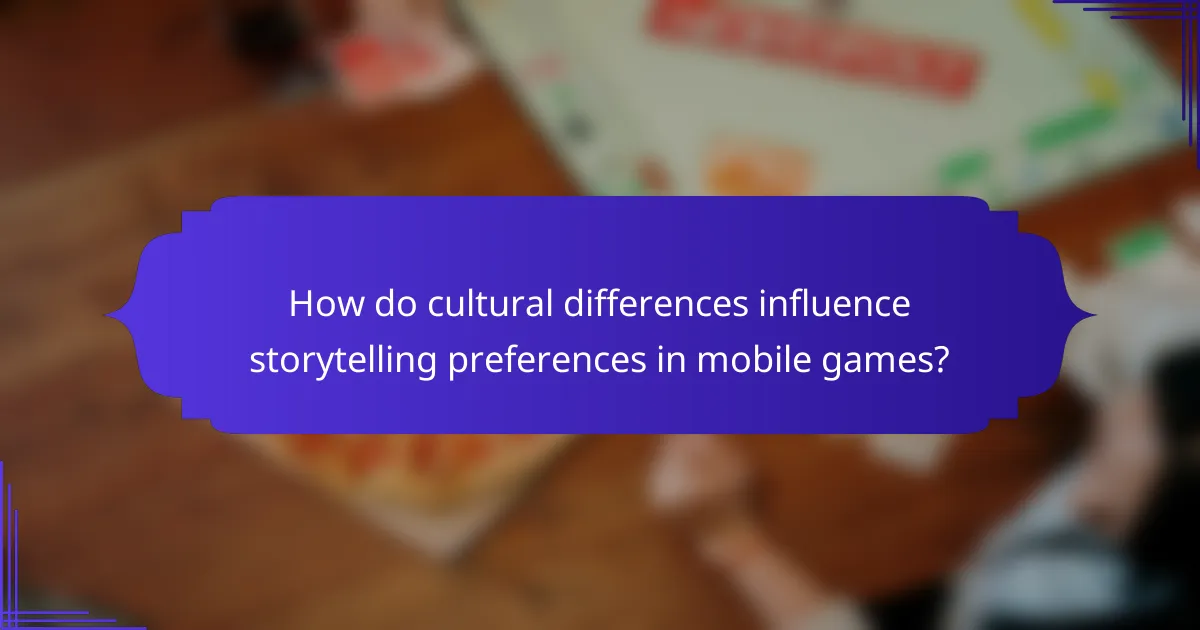Dynamic storylines in mobile games enhance player engagement through adaptability, player agency, and replayability. These elements allow narratives to shift based on player choices, creating unique experiences. Cultural influences shape storytelling preferences, impacting narrative structures and character development. Technological advancements further enrich these dynamic narratives, while developers face challenges in maintaining coherence and engagement.

How do dynamic storylines enhance player engagement in mobile games?
Dynamic storylines significantly enhance player engagement in mobile games by offering adaptability, player agency, and replayability. These elements create immersive experiences that cater to individual player choices, making each gameplay unique.
Adaptability allows the storyline to change based on player decisions, keeping the narrative fresh and responsive. Player agency empowers users to influence outcomes, fostering a sense of ownership over their journey. Replayability encourages players to revisit the game to explore different narrative paths, enhancing long-term engagement.
As a result, mobile games with dynamic storylines not only attract players but also retain them through enriched experiences that evolve with each interaction.
What are the key elements of adaptability in storytelling?
Key elements of adaptability in storytelling include dynamic plot development, player agency, and replayability. Dynamic storylines adjust based on player choices, creating unique experiences. Player agency empowers individuals to influence outcomes, enhancing emotional investment. Replayability encourages exploration of different narrative paths, increasing engagement and longevity.
Why is player agency crucial in narrative-driven mobile games?
Player agency is crucial in narrative-driven mobile games because it enhances engagement and immersion. By allowing players to make meaningful choices, games create a sense of ownership over the story. This adaptability leads to dynamic storylines that can change based on player decisions, increasing replayability. Players are more likely to return to a game when their actions significantly impact the narrative outcome, fostering a deeper connection with the game world and characters.

Which factors contribute to replayability in mobile gaming experiences?
Dynamic storylines significantly enhance replayability in mobile gaming by offering adaptability and player agency. Players experience different outcomes based on their choices, encouraging multiple playthroughs. Additionally, evolving narratives can keep the gameplay fresh and engaging. Games that incorporate branching paths or dynamic character interactions provide unique experiences, making players more likely to return. This adaptability is a key factor in maintaining interest and extending the lifespan of mobile games.
How do branching narratives impact player choices and outcomes?
Branching narratives significantly enhance player choices and outcomes by creating personalized experiences. Players engage more deeply when their decisions lead to distinct story paths. This adaptability fosters a sense of agency, encouraging exploration of different narrative outcomes. Increased replayability results as players are motivated to revisit the game to experience alternative endings and character developments. Ultimately, dynamic storylines enrich gameplay by making each player’s journey unique.
What role do randomized events play in enhancing replayability?
Randomized events significantly enhance replayability by creating unique experiences in each playthrough. These events introduce unpredictability, ensuring that players encounter different challenges and outcomes. This variability fosters player agency, as choices made in response to randomized events can lead to diverse narrative paths. Consequently, players are motivated to replay the game to explore alternative scenarios and outcomes, enriching the overall gameplay experience.

How do cultural differences influence storytelling preferences in mobile games?
Cultural differences significantly shape storytelling preferences in mobile games by influencing narrative structures and character development. Players from various backgrounds often favor different themes, such as community, individuality, or morality, which affects engagement.
For instance, Asian players may prefer collectivist narratives that emphasize teamwork and family ties, while Western players might favor personal achievement and individual heroism. This cultural context drives developers to create dynamic storylines that adapt to diverse player expectations.
Moreover, player agency is crucial; it allows users to make choices that reflect their cultural values. Replayability is enhanced when stories can be experienced differently based on these choices. As a result, mobile games that incorporate cultural nuances can lead to deeper player satisfaction and loyalty.
What themes resonate most with players in different regions?
Dynamic storylines resonate differently across regions, reflecting cultural preferences and gaming trends. In North America, players favor adaptability, seeking immersive experiences that respond to their choices. In contrast, European players often prioritize replayability, enjoying narratives that evolve with multiple outcomes. Asian markets lean towards player agency, valuing stories that allow for personalized character development and decision-making. These regional preferences highlight the importance of tailoring dynamic narratives to enhance player engagement.
How do localization practices affect narrative structure?
Localization practices significantly enhance narrative structure by tailoring storylines to cultural contexts. This adaptability fosters player agency, allowing users to make choices that impact the storyline. As a result, replayability increases, as players experience different outcomes based on localized narratives. Unique attributes, such as regional character dialogues and culturally relevant scenarios, further enrich the gaming experience, making it more immersive and engaging.

What technological advancements support dynamic storytelling in mobile games?
Technological advancements in mobile games enhance dynamic storytelling through adaptability, player agency, and replayability. Key technologies include artificial intelligence, which tailors narratives based on player choices, and procedural generation, creating unique environments and scenarios. Cloud gaming enables seamless updates and expansions, ensuring fresh content. Additionally, augmented reality immerses players in interactive storytelling, fostering deeper engagement. These innovations collectively transform narrative experiences, making them more personalized and replayable.
How does artificial intelligence enhance narrative adaptability?
Artificial intelligence significantly enhances narrative adaptability by enabling dynamic storylines that respond to player choices. AI algorithms analyze player behavior, allowing games to adjust plotlines and character interactions in real-time. This creates a unique gaming experience with high replayability, as players can explore different outcomes based on their decisions. The integration of machine learning further personalizes narratives, ensuring that each player’s journey feels distinct and engaging. This adaptability not only increases player agency but also deepens emotional investment in the storyline.
What are the benefits of using procedural generation in storytelling?
Using procedural generation in storytelling enhances adaptability, player agency, and replayability in mobile games. It allows for unique narratives that change based on player choices, leading to diverse experiences. This dynamic approach keeps players engaged by offering new scenarios and outcomes with each playthrough. As a result, games can maintain longevity and interest, encouraging repeated exploration of the story.

What challenges do developers face when creating dynamic storylines?
Developers face challenges in balancing player agency, narrative coherence, and technical limitations when creating dynamic storylines. Adapting to player choices can lead to complex branching narratives, making it difficult to maintain a cohesive story. Ensuring replayability requires careful design to keep players engaged without feeling repetitive. Additionally, technical constraints, such as memory and processing power, can limit the depth of interactions and the number of potential story paths.
How can balancing player agency and narrative coherence be achieved?
Balancing player agency and narrative coherence can be achieved through careful design choices. Developers can implement branching storylines that allow player decisions to influence outcomes while maintaining a consistent narrative arc. This ensures players feel their choices matter without compromising the overall story.
Incorporating dynamic dialogue systems enhances player agency, offering varied interactions that align with narrative goals. Playtesting these elements helps identify potential inconsistencies, ensuring the story remains cohesive despite player choices.
Additionally, using adaptive storytelling techniques, such as reactive environments and character responses, fosters immersion and reinforces narrative coherence. This approach keeps the story engaging while allowing for player-driven exploration and replayability.
Ultimately, a well-structured framework that prioritizes both player choices and narrative integrity leads to a richer gaming experience.
What are common pitfalls in implementing adaptive storytelling?
Common pitfalls in implementing adaptive storytelling include lack of clear player agency, inadequate testing of dynamic elements, and failure to balance narrative depth with gameplay mechanics. These issues can lead to player frustration and diminish the overall experience. Ensuring that choices have meaningful consequences is crucial for maintaining engagement. Additionally, overly complex storylines may confuse players, reducing replayability and enjoyment.

Which successful mobile games exemplify dynamic storytelling?
Games like “Life is Strange” and “The Walking Dead” showcase dynamic storytelling through player choices and branching narratives. These games adapt to player decisions, enhancing engagement and replayability. “Firewatch” offers a unique narrative experience with limited player agency, emphasizing emotional depth. “Oxenfree” combines supernatural elements with character-driven dialogue, creating a compelling story that changes with player interactions. “80 Days” presents a rare blend of exploration and narrative, allowing players to craft their journey through various paths. Each title exemplifies how dynamic storylines can enrich mobile gaming experiences.
What lessons can be learned from case studies of popular titles?
Dynamic storylines in mobile games teach valuable lessons about player engagement and experience. Key insights include the importance of adaptability, which allows narratives to shift based on player choices, enhancing emotional investment. Replayability emerges as a crucial factor, encouraging players to explore different outcomes and story paths. Additionally, fostering player agency empowers users to shape their gaming experience, leading to a more personalized journey. These elements collectively contribute to sustained player interest and satisfaction.
How do these games maintain player interest over time?
Dynamic storylines maintain player interest through adaptability, player agency, and replayability. These elements create immersive experiences that evolve based on player choices, enhancing engagement over time.
Adaptability allows the game to shift narratives in response to player actions, keeping the storyline fresh. Player agency empowers users to make impactful decisions, leading to diverse outcomes. Replayability encourages players to revisit the game to explore different paths and endings, ensuring sustained interest.
Incorporating these features fosters a dynamic gaming environment, making each playthrough unique and captivating.
What best practices can developers adopt for effective storytelling?
Developers can adopt several best practices for effective storytelling in mobile games. Emphasizing adaptability allows storylines to evolve based on player choices, enhancing engagement. Prioritizing player agency fosters a sense of ownership, making decisions impactful. Ensuring replayability encourages players to revisit the game, exploring different narrative paths. Additionally, integrating rich character development and immersive worlds deepens emotional connections, enhancing the overall experience.
